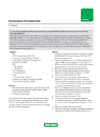-
US | en
-
Contact and Support
-
Technical Support
-
Antibody Protocols
-
ELISA Protocols
-
PK Bridging ELISA Measuring Free Drug Protocols
- Anti-abatacept
- Anti-adalimumab
- Anti-atezolizumab
- Anti-avelumab
- Anti-avelumab (TZA040P, TZA041)
- Anti-belatacept
- Anti-bevacizumab
- Anti-brentuximab vedotin
- Anti-cemiplimab
- Anti-cetuximab
- Anti-daratumumab
- Anti-denosumab
- Anti-dupilumab
- Anti-dupilumab (TZA014,TZA015P)
- Anti-dupilumab (TZA016,TZA017,TZC002P, TZC002B)
- Anti-durvalumab (TZA004, HCA360)
- Anti-eculizumab
- Anti-etanercept
- Anti-evolocumab
- Anti-evolocumab (TZA007, HCA376)
- Anti-golimumab
- Anti-infliximab
- Anti-ipilimumab
- Anti-natalizumab
- Anti-nivolumab
- Anti-obinutuzumab
- Anti-ocrelizumab
- Anti-ocrelizumab (TZA044,TZA045)
- Anti-omalizumab
- Anti-palivizumab
- Anti-panitumumab
- Anti-pembrolizumab
- Anti-pertuzumab
- Anti-rituximab
- Anti-secukinumab
- Anti-tocilizumab
- Anti-trastuzumab (HCA166, HCA168)
- Anti-trastuzumab (HCA169, HCA176P)
- Anti-trastuzumab (HCA169, HCA177P)
- Anti-trastuzumab (HCA169, HCA270)
- Anti-ustekinumab (HCA208, HCA210)
- Anti-ustekinumab (HCA209, HCA210)
- Anti-vedolizumab
-
PK Bridging ELISA Measuring Free Drug Protocols
-
ELISA Protocols
-
Antibody Protocols
-
Technical Support
s

Protocol: PK Bridging ELISA for Use with Anti-Abatacept Antibodies
Pharmacokinetic (PK) Bridging ELISA: for Use with Mouse Anti-Human CTLA-4 (CD152) Antibody MCA1724 and Human Anti-Abatacept Antibody HCA335
Abatacept is a recombinant, fusion protein drug consisting of the extracellular domain of human cytotoxic T-lymphocyte-associated antigen 4 (CTLA-4, also known as CD152), linked to a modified Fc portion of human immunoglobulin G1 (hIgG1). This method provides a procedure for carrying out a PK ELISA with Mouse Anti-Human CTLA-4 (CD152) Antibody, catalog number MCA1724 (capture antibody), and Human Anti-Abatacept Antibody, HCA335 (detection antibody), and using abatacept for the standard curve. The method should always be used in conjunction with product and batch specific information provided with each vial (see product datasheets). This protocol will need to be adjusted for use with different detection methods and immunoassay technology platforms.
View all of our anti-abatacept antibodiesReagents
- BSA
HISPEC Assay Diluent (BUF049)
Human Serum (Sigma-Aldrich, H4522)
LYNX Rapid HRP Antibody Conjugation Kit (LNK001P-LNK006P) - PBS
- 136 mM NaCl
2.68 mM KCl
8.1 mM Na2HPO4
1.46 mM KH2PO4 - PBST
- PBS with 0.05% Tween 20
- QuantaBlu Fluorogenic Peroxidase Substrate (Thermo Fisher Scientific, 15169)
Materials
- 384-well microtiter plate, black, square flat-bottom wells, e.g. Black 384-Well Immuno Plates (Thermo Fisher Scientific, 460518)
- Fluorescence plate reader
- 96-well plates can be used instead of 384-well plates (black, flat-bottom wells) e.g. Black 96-Well Immuno Plates (Thermo Fisher Scientific, 437111). For the 96-well format, use 100 µl (instead of 20 µl) of antigen, antibodies, or substrate and 300 µl for the blocking step.
Method
- Prepare the detection Anti-Abatacept Antibody: conjugate HCA335 (AbD37058ia) using a LYNX Rapid HRP Antibody Conjugation Kit.
- Prepare the capture Anti-CTLA-4 Antibody MCA1724 at 1 µg/ml in PBS. Coat the required number of wells of a 384-well microtiter plate with 20 µl per well of the prepared capture antibody, and incubate overnight at 4°C.
- Wash the microtiter plate five times (5x) with PBST.
- Block the microtiter plate by adding 100 µl 5% BSA in PBST to each well, and then incubate for 1 hr at RT.
- Wash the microtiter plate 5x with PBST.
- For the standard curve, prepare a dilution series of abatacept in 10% human serum in PBST in triplicate. Final concentration of abatacept should cover the range from 0.01 ng/ml to 4,000 ng/ml. Include a zero abatacept concentration as the background value.
- Add 20 μl of abatacept dilution per well (in triplicate for each standard recommended). Add 20 μl of each test sample to the other wells (in triplicate for each sample recommended). Incubate for 1 hr at RT.
- Wash the microtiter plate 5x with PBST.
- To each well, add 20 µl HRP conjugated detection Anti-Abatacept Antibody, HCA335 (AbD37058ia), at 2 µg/ml in HISPEC Assay Diluent. Incubate for 1 hr at RT.
- Wash the microtiter plate 10x with PBST.
- Add 20 µl QuantaBlu Fluorogenic Peroxidase Substrate to each well and measure the fluorescence after 30 min.
